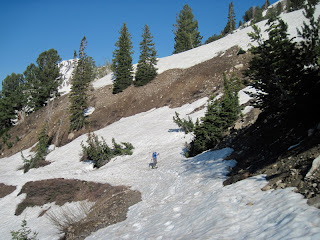It is quite remarkable how much the vegetation can change in just a couple hundred meters in the Wasatch Range.
Today I had a chance to experience the lush lowland oasis that is Ferguson Canyon, a minor canyon just south of Big Cottonwood Canyon. Despite having lived in Salt Lake for more than 15 years, it was my first trip, but won't be my last!
The trail starts at 5000 feet on a west facing aspect. The vegetation here is a mix of grass, wildflowers, and sage, which is unusually lush for late June given the historically wet spring we just experienced.
A short walk around the corner, however, and you enter an incredibly lush "jungle" along the stream that today was "raging" down Ferguson Canyon, which was pleasantly cool.
Several factors contribute to the microclimate in Ferguson Canyon. Although the canyon faces roughly west, it has an abrupt steep ridge immediately to its south, which reduces the net solar radiation in the canyon. Then, the stream and high water table enable an abundance of plant life, so that a substantial fraction of the solar energy that is received is used for evapotranspiration rather than sensible heating of the atmosphere. This also reduces the magnitude of the daily temperature range, so that temperature extremes are not as large.
You can find microclimates of this type throughout the Wasatch. They contrast with what happens on exposed south-facing slopes, where the net solar radiation is maximized. For example, on the south face of Wilson Peak, one can find sagebrush at altitudes of more than 9000 feet.
But there is another remarkable microclimate that we experience every day, and that is the human-modified climate of the Salt Lake Valley. From the viewpoint above Ferguson Canyon, once can easily see the "urban forest" that we have cultivated in the valley during the past 150 years.
 |
| Looking west from the viewpoint above Ferguson Canyon |
Cities in the east have a lack of forest and an excess of concrete, asphalt, and impervious surfaces. This leads to the well-known "urban heat island." The situation in Salt Lake, however, is more complicated. The natural vegetation before human settlement was grass. Annual precipitation was 15-25 inches. We replaced that natural vegetation with roads and buildings, but we have also imported water and plated trees, as is readily apparent in the photo above. Irrigation in the Salt Lake Valley has a cooling effect that partially offsets other urban effects. Beyond evapotranspiration, the effect of trees includes changes to the long- and short-wave radiation budget.
To my knowledge, these issues have not been deeply explored so that we have a comprehensive knowledge of urban effects on climate in the Salt Lake Valley. For example, to what degree does the "oasis effect" from urban irrigation offset warming imposed by other urban effects? What is the impact of trees and how does that impact very seasonally? These are questions that seem simple, but are actually quite difficult to answer.

 Dust events associated with convective downdrafts are informally known as "Haboobs." They originate from local sources, do not last very long, and are quite common in Utah. The second event is going on now...
Dust events associated with convective downdrafts are informally known as "Haboobs." They originate from local sources, do not last very long, and are quite common in Utah. The second event is going on now...
















































